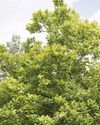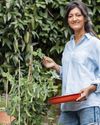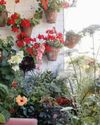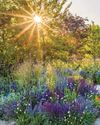
July has always been a favourite month because everything is full and bountiful. We can walk through our gardens, picking crops and eating them without a care in the world.
In my main garden, flowers are in full bloom and, with my 'hassle-free food' hat on, it's worth discussing the edible flowers among them because they're more useful than they might seem. There was a time when I considered eating flowers a bit of a novelty. Now, though, I see flowers as an entirely new category of hassle-free harvests in the same way herbs sit alongside vegetables and fruit.
Flowers bring colour to our plates as well as unique textures and subtle flavours. Grow perennial or self-sowing flowers and they'll crop every year for no effort. It can feel a bit odd eating flowers at first, but push past that and I promise you'll never look back. Best of all, because edible flowers don't last long in shops, they're a treat for the home grower.
Harvest
Monarda is a particularly hassle-free flower to grow. A member of the mint family (though not as vigorous a spreader), its leaves, flowers and young shoots are edible - the leaves make a good tea. The petals taste like a mild cross between mint and Earl Grey tea, and I use them to decorate salads and cakes.
I've eaten the petals of Salvia x jamensis 'California Sunset, which is sold for culinary use in America. Mild in flavour with a hint of sugar from the nectar (which you can suck out), they're also great for desserts and to garnish cold drinks. Similarly useful are some viola petals, which are among the tastiest of flowers, while nasturtium flowers have a peppery kick better suited to salads. I also sacrifice a few courgette flowers to eat when they first open because they're delicious raw, as well as stuffed and cooked.
Diese Geschichte stammt aus der July 2024-Ausgabe von BBC Gardeners World.
Starten Sie Ihre 7-tägige kostenlose Testversion von Magzter GOLD, um auf Tausende kuratierte Premium-Storys sowie über 8.000 Zeitschriften und Zeitungen zuzugreifen.
Bereits Abonnent ? Anmelden
Diese Geschichte stammt aus der July 2024-Ausgabe von BBC Gardeners World.
Starten Sie Ihre 7-tägige kostenlose Testversion von Magzter GOLD, um auf Tausende kuratierte Premium-Storys sowie über 8.000 Zeitschriften und Zeitungen zuzugreifen.
Bereits Abonnent? Anmelden

A new plot for tasty crops
Taking on a new allotment needn't be hard work. By simply following a few easy tips you can have bumper crops in no time, just like Alessandro Vitale

We love July
July is an island floating between the joy of June and the slightly fatigued month of August. It's a grown-up month: the year has shrugged off its adolescent exuberances, the weather is (hopefully) warm enough for ice cream to be one of your five a day, the sea should be swimmable without (too much) danger of hypothermia and thoughts will be of holiday shenanigans and family barbecues. School's out this month, the next tranche of glorious summer colour is washing across our borders and it's my birthday. Lots of reasons to give three rousing cheers for July!

YOUR PRUNING MONTH
Now, at the height of summer, Frances Tophill shows how to boost your plants' health and productivity with a timely cut

Hassle-free harvests
Flowers are out in abundance this month and for Jack Wallington, many of these blooms make delicious, low-effort pickings

Bite-sized bounties
Glorious doorstep harvests can easily turn into gluts, so let Rukmini Iyer's recipes help you savour every last bit

Upcycled outdoor living
Create unique and stylish garden features for minimal cost using reclaimed materials and simple DIY skills. Helen Riches shares four step-by-step projects and more inspiring eco tips

Secrets of a COLOURFUL GARDEN
Buildings and landscapes can play a vital role in supercharging your space, as Nick Bailey demonstrates

Greening up a city balcony
Looking for sustainable, small-space gardening ideas? Take inspiration from Oliver Hymans' transformed balcony garden in north-east London - now a lush, green haven for humans and wildlife

The dry and mighty garden
As we adapt our gardens to a more volatile climate, Alan Titchmarsh reveals how to create a drought-tolerant plot and picks his top plant performers

Nature knows best
Carol Klein explains how to choose plants for specific growing conditions, based on what has naturally adapted to thrive there